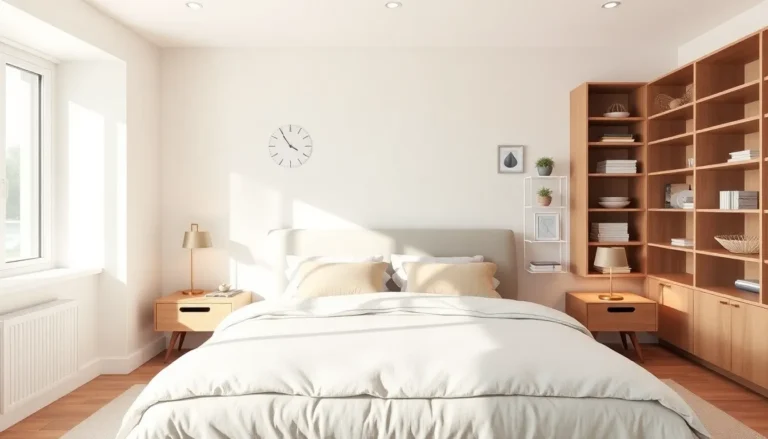Table of Contents
ToggleImagine walking into your dream home, where every corner reflects your unique style and personality. Thanks to AI for home design, that vision isn’t just a fantasy. It’s now a reality that’s as easy as clicking a button. This technology is revolutionizing the way homeowners and designers approach interior spaces, making it possible to create stunning designs without breaking a sweat—or the bank.
Overview of AI for Home Design
AI technology transforms home design by offering personalized, stylish interiors that cater to individual tastes. Homeowners and designers can now access affordable tools that simplify the creation of unique living spaces.
What Is AI for Home Design?
AI for home design refers to software and platforms that leverage artificial intelligence to assist users in planning their interiors. These tools analyze user preferences and suggest designs, layouts, and color schemes that enhance aesthetic appeal. By processing vast amounts of design data, AI provides recommendations tailored to specific needs and styles.
Key Features of AI Tools
AI tools come equipped with several features that simplify the design process. Visualization capabilities allow users to create 3D models of their spaces. Real-time feedback lets users experiment with various configurations instantly. Access to design templates accelerates the creative process, while cost estimation tools provide budget-friendly options. Integration with smart home technology enables seamless adjustments and smart solutions for modern living.
Benefits of Using AI in Home Design

AI in home design offers numerous advantages, making it easier for users to create their ideal living spaces. This technology streamlines processes and enhances creativity.
Enhanced Creativity and Inspiration
AI tools provide endless design ideas tailored to individual preferences. Users can explore various styles and themes without limits. Algorithms analyze existing designs and suggest unique alternatives, elevating the creative process. Virtual reality features allow users to visualize multiple layouts, helping them find inspiration promptly. Design software often showcases current trends, sparking fresh ideas and influencing personal aesthetics.
Improved Efficiency and Time Savings
AI significantly reduces the time required for home design projects. Automated calculations and real-time feedback streamline decision-making. Access to a range of templates enables users to select or modify designs quickly. Instead of spending hours sketching or manually sourcing materials, AI simplifies these tasks within moments. Clients receive immediate information on costs and options, which speeds up the selection process. These efficiencies ultimately transform the design experience, making it more enjoyable and productive.
Popular AI Tools for Home Design
Various AI tools revolutionize home design, making it accessible and efficient. These platforms streamline the process, offering tailored solutions to meet individual needs.
Tool 1: Features and Use Cases
SketchUp utilizes AI to enhance 3D modeling. This tool allows users to create precise designs with user-friendly features. Real-time collaboration promotes feedback between users, making it suitable for both professionals and DIY enthusiasts. By accessing vast libraries of templates, users can experiment with layouts effectively. AI algorithms provide cost estimations, ensuring budget-friendly projects without sacrificing style. Popular use cases include interior renovations and landscaping designs.
Tool 2: Features and Use Cases
Homestyler combines AI with intuitive design capabilities. This tool enables users to visualize their spaces through interactive 3D rendering. Users can drag and drop furniture, experiment with color schemes, and adjust layouts easily. Features like photorealistic imagery foster creative exploration, perfect for homeowners and designers alike. With a community-driven platform, users share their designs, inspiring others. Common use cases include staging online listings and planning room layouts.
Challenges and Limitations
Despite its advantages, AI for home design presents several challenges and limitations that users should consider.
Cost Considerations
Cost can vary significantly among AI design tools. Many platforms require subscriptions or one-time fees, which may deter budget-conscious users. While some options provide free trials or basic features at no cost, advanced functionalities often come with higher price tags. Users must evaluate the return on investment for these tools, ensuring they align with their design goals. Selecting a cost-effective solution is essential, especially for individuals managing tight budgets or planning extensive renovations.
Learning Curve for Users
Learning to navigate AI tools can be daunting for some users. Although many platforms aim for user-friendliness, mastering all features requires time and practice. Tutorials and user guides exist to aid beginners, but initial confusion can occur. Familiarity with technology impacts the ease of use; individuals less comfortable with digital tools may experience frustration. Overcoming this learning curve is critical for harnessing the full potential of AI in home design.
AI is reshaping the landscape of home design by making it more accessible and personalized. With innovative tools at their fingertips, users can explore a myriad of design possibilities that cater to their unique tastes and preferences. The integration of AI not only enhances creativity but also streamlines the design process, allowing for quicker decision-making and cost estimation.
While challenges like costs and a learning curve exist, the benefits of utilizing AI far outweigh these hurdles. As technology continues to evolve, homeowners and designers alike can look forward to even more intuitive solutions that simplify the journey to creating their dream spaces. Embracing AI in home design is a step towards a more efficient and inspired approach to interior aesthetics.







